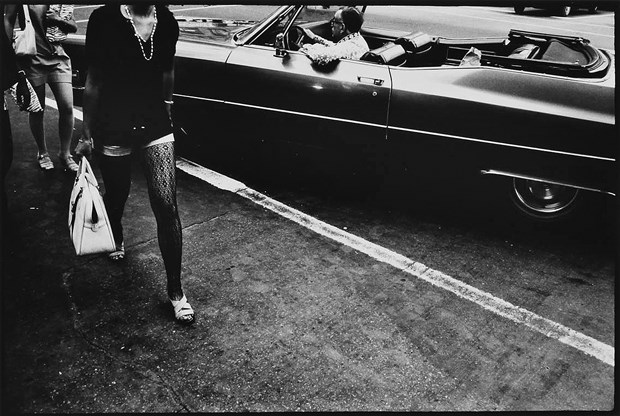B.C. Almanac(h) C-B, Presentation House Gallery until Nov. 29. For more information visit presentationhousegallery.org.
Hippies in headbands, the sexual revolution, unabashed nudity and anti-war movements all come to life in a remounted photography exhibition -a nostalgic rewind for B.C. folks that came of age in the 1970s.
B.C. Almanac(h) C-B, on display from now until Nov. 29 at North Vancouver's Presentation House Gallery, brings to light a little-known chapter in Vancouver's relatively recent art history.
In 1970 the Stills Division of the National Film Board of Canada commissioned Vancouver artists Jack Dale and Michael de Courcy to create a West Coast-centred photography exhibition that captured the lifestyle of the day.
The B.C. arm of the project, which overall was a public relations campaign for the government, was to correspond with similar exhibitions about Canadian life already being produced in the eastern part of the country.
Dale and de Courcy embraced the assignment and took some creative license with how the exhibit was to be executed. "We had this sort of unconventional idea that the show should be more popular culture oriented than a salon kind of gallery exhibition. We felt photography was better consumed that way," says de Courcy, speaking to the News this week.
Dale and de Courcy figured people would better comprehend the images if they were in a magazine rather than on the walls of a gallery where he said there may be "interference from snobby high culture kind of stuff."
So what they proposed instead was a publication, photographic booklets.
"A lot of sort of the conventional photographers working in Vancouver at the time wouldn't be interested in the far out ideas we had of publishing instead of exhibition, and giving everyone access to their own little booklets and printing it on newsprint - that was very radical too because everyone knows that newsprint doesn't give you the highest resolution images," says de Courcy.
"But we chose to do that because we wanted it to kind of look like a mass produced object, like a comic book or something like that."
Commissioning 15 West Coast artists from different mediums, Dale and de Courcy put together these photographic booklets, one from each artist, that were compiled into an anthology called B.C. Almanac(h) C-B. The "(h) C-B" represents the French translation of the words almanac and B.C. to include both official Canadian languages.
Each artist, including a sculptor, a painter and a poet, some with no photography experience, set out to capture a snapshot of their life and surroundings in 1970.
A lifestyle revolution was emerging and young people, who were forging a different path than their parents, thought it was special and they wanted to record it, recalls de Courcy, whose photos are also contained in the B.C. Almanac.
"They felt like they were sort of on the cutting edge and photography was right there ready to use as an art form to record these changes," says de Courcy. "It was a lifestyle manual in fact for that era."
Flipping through the booklets the images are organically captured and depict quintessential 1970s lifestyle: a young man walking in a group with guitar slung over his shoulders; a couple strolling through a daisy patch in the buff.
Other artists' booklets focus in on the drug culture of the day by showing a couple smoking drugs, and the sexual revolution, including an image of a man with the words "sex relives tension" written on his back.
A nude portrait series featuring both men and women figures prominently in the Almanac, alongside photos of a mass of people taking part in anti-war and anti-abortion protests.
In another booklet, meanwhile, you see cars and transport trucks blurrily travelling down a highway.
The Almanac also contains a snapshot of the fashion of the day: vests of every design, a Lee jean jacket, billowy tunics and ubiquitous floral patterns. De Courcy chronicled the birth of his daughter for his booklet, getting behind the lens six months before his wife became pregnant and following her through pregnancy and the birth of their child.
It wasn't a conceptual approach, de Courcy explains of the sequential series of photographs.
"I was crazy about taking pictures. And when I got interested in a subject I just took pictures of that subject all the time," says de Courcy, of his now 40-year-long photography passion.
There is a personal connection for de Courcy in that his father was an amateur photographer who died several months before he was born. While he was growing up, de Courcy's mother would give him supplies from his dad's darkroom and other camera parts.
"So I sort of grew up playing with those things, and that kind of planted the (photography) idea," he says.
B.C. Almanac(h) C-B's content has become the subject of a touring exhibition, having been previewed in New York and soon to be shown in LA. A multimedia version of the book, complete with walls painted greyscale is part of Presentation House Gallery's remounting of B.C. Almanac(h) C-B.
The gallery has also undertaken a republishing of the book, which contains no originals but rather photos of pages in the Almanac booklets. Complementing Presentation House's B.C. Almanac(h) C-B exhibit is a multimedia display from the 15 artists: Dale, de Courcy, Christos Dikeakos, Judith Eglington, Gerry Gilbert, Roy Kiyooka, Glenn Lewis, Taras Masciuch, NE Thing Co. Ltd., Michael Morris, Jone Pane, Timothy Porter, Peter Thomas, Vincent Trasov, and Robertson Wood.
"You see what the artists who were in the almanac, the work that they were doing simultaneous to that project," says de Courcy, whose iconic image boxes are featured in the exhibit.
Forty-five years later and the exhibit and the images still hold up, figures de Courcy.
"This is kind of opening that up and bringing that chapter forward so that the current generation ... it's like recycling, it's great, you know to be able to suddenly breathe life into this ancient project and make it meaningful," says de Courcy.



